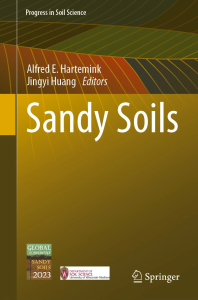Anyone working the land in Florida is aware just how sandy the soil is throughout the panhandle and peninsula. Even the official state soil is Myakka fine sand. So, it is not surprising the first book solely focused on sandy soils includes authors from the UF/IFAS department of soil, water, and ecosystem sciences (SWES). With their keen knowledge of the subject, several members of SWES collaborated to write three of the book’s chapters. “Sandy Soils” is a title in the Progress in Soil Science series from the publisher Springer Nature.
 Enhanced Weathering to Enhance Carbon Sequestration in Sandy Soils
Enhanced Weathering to Enhance Carbon Sequestration in Sandy Soils
Doctoral student Ryan Champiny and her faculty advisor, Dr. Yang Lin, an assistant professor of soil health, authored the lead chapter in the Soil Carbon and Soil Health section. It is based on their research into the use of basalt, olivine, dolomite, or finely crushed concrete as an agricultural soil amendment. These materials provide a promising method of carbon sequestration. Specifically, calcium silicate and hydroxide minerals can remove CO2 during its weathering processes.
“Besides carbon sequestration, these types of material can weather into fine particles that help to stabilize soil organic matter,” Champiny explained. “They also can increase soil water-holding and nutrient-retention capacity.”
However, research shows the weathering of basalt, olivine, and industrial waste may also release heavy metals. Those would pose adverse environmental and health impacts. The chapter provides an overview of the weathering process and its potential application for sandy soils.
Characterization of Phosphorus Sorption of Some Sandy Soils in Florida with Microscopy and Computer Vision
Also in the Soil Carbon and Soil Health section is research from doctoral student Perseverança Mungofa, her faculty advisor, Dr. Arnold Schumann, a professor of citrus nutrition, and his lab manager, biological scientist Laura Waldo. Their research investigated soils collected across agriculturally important areas of Florida. It focused on the soils’ phosphorus (P) sorption capacity and the relationships with soil organic matter, particle size, and bulk density, among other characteristics.
The soils of Florida are formed predominantly from sandy marine sediments. Much of this region’s landscape is dominated by sandy textured particles that are either coated or uncoated.
“These coatings contain clay minerals with iron and aluminum oxides or complexes of minerals and soil organic matter,” Mungofa explained. “Those have a particular relevance for soil-plant health, nutrient cycling, and plant-nutrient-water dynamics.”
They analyzed samples to quantify the amount of phosphorus the sand particles’ sorption sites held.
“We photographed each soil sample five times to explore the potential of deep learning, computer vision, and deep convolutional neural networks for categorization of sorption capacity from digital microscopic imagery,” Schumann said.
They applied K-Means++ clustering along with CNN (EfficientNet-B4) algorithms for feature extraction and unsupervised image classification. From the clustering analysis, they grouped the soil images into ten classes. Those were then subjected to ANOVA with Tukey-HSD multi-comparison analysis for all variables. Based on the results from laboratory data and imagery analysis, the presence of coated sands can be an indicator of the soil’s capability to retain nutrients and pollutants, improve water-holding capacity, and prevent the loss of nutrients by leaching.
Irrigation Practices for Enhanced Water Management of Citrus on Sandy Soils in Florida
As common as it is to associate sandy soils with Florida, so too is the state’s connection with citrus. Dr. Alisheikh Atta, a current postdoctoral associate, Dr. Kelly Morgan, a professor of soil fertility and water management, Dr. Said Hamido, a former postdoctoral associate, and Dr. Davie Kadyampakeni, an associate professor of citrus water and nutrient management, contributed to a chapter on Huanglongbing (HLB)-affected citrus trees. The disease poses a challenge on Florida’s sandy soil when it comes to water and nutrient dynamics.
Their study had three objectives:
- Examine commercial citrus groves with varying tree densities
- Investigate the impact of irrigation rate as a function of reference evapotranspiration (ETo)
- Determine the relationship between water application and uptake at selected irrigation rates
“We detected significant water accumulation and dynamics differences across the soil profiles (0–55 cm) in response to the irrigation applied,” Atta said.
Among the other findings: The lowest water storage was detected during the dry months (April and May). Increased water tables have been observed during the summer seasons (June–September). Meanwhile, significant root length densities had been recorded with deficit irrigation with 50%-ETo and 78%-ETo in the three rows and two rows, respectively. Within the deficit irrigation, the 78%-ETo had significantly the highest root density and uniform soil wetting pattern during the growing seasons of the 2-year study.
You can find more information on Sandy Soils here: https://link.springer.com/book/10.1007/978-3-031-50285-9
Source: UF/IFAS Pest Alert
Note: All images and contents are the property of UF/IFAS.



